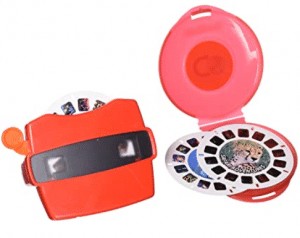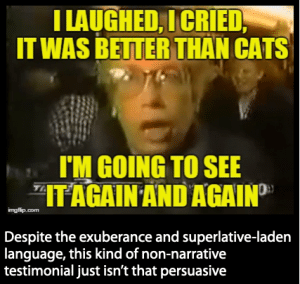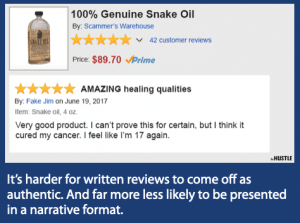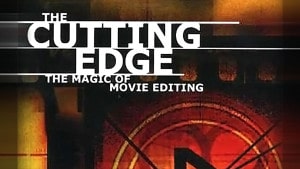 Remember that classic 80s toy, the Viewmaster?
Remember that classic 80s toy, the Viewmaster?
It was basically a modern day stereoscope.
You took an image disc and put it into what looked like a futuristic binocular that then displayed slightly different images to your left and right eyes.
And voila, you got a cool 3-dimensional image out of it.
It’s the same basic technique used by 3-D movies, and the same underlying principle behind stereo sound.
The point is you’ll want to harness this same principle to boost the persuasive powerful of testimonial-driven ads.
You want the storytelling of your ad to present two perspectives:
- The customer’s, and
- The company’s or owner’s
And while you definitely want the stories to corroborate each other, you want enough of a difference in perspective to create that magical, 3-D persuasion.
Here’s how most people screw that up, and how you can make sure you get it right.
3 Common Mistakes from Testimonials
Mistake #1: Non-Narrative Testimonials
A pure recommendation — “These guys are awesome. I highly recommend them” — isn’t that persuasive.

Even with added substantiation — “These guys are awesome, their attention to detail and professionalism were top notch. I highly recommend them” — a pure statement of recommendations remains flat and relatively uninspiring.
For a testimonial to be powerful, it has to be placed into narrative form. And that means there has to be a beginning, middle, and end.
Which means there will be some before and after transformation baked in, as well as a “beginning” that features some pain points and concerns of the customer.
“I’d had several other people out to fix my AC problem, and they never really made it better. I’d heard about [Client], but wasn’t sure about them until I saw/heard X. Wow! What a difference — they came out, diagnosed the problem right away, and I’ve never had to deal with [humidity] again.”
Powerful testimonials act as mirrors in which prospective customers can see themselves. They recognize the previous customers problems and concerns, and then they finish the testimonial to learn about the solution.
The testimonial is providing them with a script to follow to get to that same happy ending.
If you don’t provide a before image with a problem and concern, then you’re cutting to the end of the movie, and robbing the climax of all its power.
Mistake #2: Non-Recorded Testimonials
Most of us speak in a different voice than we write. If you ask people to write you a review or provide a testimonial in writing, they’ll likely give you something that lacks that authentic spark.
When you record a testimonial on the other hand, you can get their natural cadences and authentic responses.
 Note, you may have to record five to ten minutes of a testimonial to get 10 or 15 seconds of animated, authentic magic, with maybe another 20 seconds of natural speaking, but you can still capture and sift out that magic, which would be impossible from writing.
Note, you may have to record five to ten minutes of a testimonial to get 10 or 15 seconds of animated, authentic magic, with maybe another 20 seconds of natural speaking, but you can still capture and sift out that magic, which would be impossible from writing.
So why do so many people settle for written testimonials?
Written reviews are a thousand times easier.
You don’t have to interview the customer and record anything. You can just e-mail them a request for a review.
There are even software services to automate the process.
Unfortunately, not only are written testimonials one thousand times easier, they’re also ten thousand times less persuasive.
Powerful, recorded testimonials can move mountains for you. They’re worth the extra effort.
Mistake #3: Non-Edited Testimonials
The thing about recorded, interview-led testimonials, is they’ll almost always need to be edited.
 And not only in the sense of winnowed down, but in the sense of re-arranging the good bits into a strong narrative arc.
And not only in the sense of winnowed down, but in the sense of re-arranging the good bits into a strong narrative arc.
The problem with this is the need for connective tissue between the good bits.
And the solution to that problem brings us back to the stereoscopic nature of 3-D testimonials: You’ll want to use another voice and perspective.
In most cases, you’ll want to intercut between the owner and the customer, but occasionally you can use employees either instead of the owner or in addition to them.
Another way to edit testimonials is to inter-splice multiple customers testimonials into a montage.
Either way, you’ll want to apply editing magic to the mix.
What Success Sounds Like
Now that I’ve explained the process, let me show you an example of what a 3-D Testimonial sounds like as a finished product:
Example 1:
Example 2:
Do you see how the framing and 2nd perspective by the owner helps add punch and persuasion to the recorded testimonial?
And can you see how that whole process makes the claims made in non-testimonial ads seem that much more believable?
That’s the power of 3-D Testimonials.
How to Interview Customers to Get Maximum Persuasive Magic
The secret to getting persuasive, narratively constructed testimonials is to interview your customers with a series of questions that contain a built-in narrative arc.
You’ll want to customize these questions to your industry and company, but this generalized list of questions will get you started:
- What was your situation like before you [bought from us]?
- What was your biggest issue or problem?
- What concerns did you have about buying [from us / from a provider / etc?]
- What other solutions did you consider?
- What made you buy from us?
- When did you know you’d made the right decision?
- What was the best part of doing business with us?
- What are things like now? How is it different from before?
- If someone else was in your position and thinking of buying from us, but was on the fence, what would you say to them?
So now that you know what to do, go put someone in charge of interviewing happy customers and recording their testimonials.
Then have your ad consultant edit them down and bake them into your ads inter-spliced with your own statements.
You’ll thank me after you do — guaranteed.
And if you don’t have an ad consultant who can do that for you, reach out and let me know.
- Getting a Foot in the Door — Of Perception - November 27, 2025
- What Digital Superstars Know About Offline Advertising - November 17, 2025
- Unmistakable: A Tale of Two Boots and Branding Done Right - November 8, 2025
